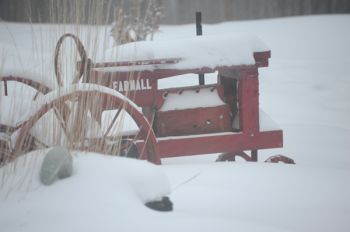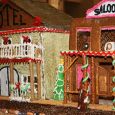The Gift of South Dakota
Subscriptions to South Dakota Magazine make great gifts!
Subscribe today — 1 year (6 issues) is just $29!
A Depression Christmas
Dec 23, 2014
It was Christmas time on the farm during the Depression in South Dakota. The harsh wind swept across the plains and entered the cracks around the windows and doors in our house. The hot days of summer were a faded memory. Our crops were meager at best, but we always produced a bumper crop of children. The number of kids in the small house grew with each passing year until it hovered at 10, by far the best crop during those bleak years.
The week before Christmas held lots of excitement in our household and local community. There was the annual program put on by children at the small country school. As with most child-headed projects, the results were often mixed and surprising each year — anything could happen and generally did. We sang traditional carols while our mother played the old pump organ, which had been home to mice during the summer. In its old age not every key produced sound — and the sounds it did happen to produce were of questionable quality — but it served the school well and was a wonderful way to drown out off-key interpretations of "Jingle Bells" from the children. My mother played the organ with gusto, but it often required my brother lying on the floor and pushing the pedals when she became tired.
A second program followed at the country church, again with questionable talent. Everyone learned the speaking parts in case Joseph or the wise men came down with the flu or the measles, a common occurrence in that day. Santa was always played by one of the local men, no doubt chosen by drawing straws due to the moth-eaten dusty suit they were required to wear. Santa always came bearing candy for the children, which was greatly anticipated.
Memories of Christmas Eve at home began with a huge kettle of oyster stew sitting on the back of the wood stove. This was an extra extravagance that we could ill afford, but a beloved uncle in Washington, D.C., provided the feast by sending $5 for the oysters. How we savored the taste.
The tree had definitely seen better days, as every other branch was missing. It seemed to plead to be put out of its misery. Our rings of green and red paper chains covered the bare parts. One year we attempted to string popcorn but failed miserably because the popcorn was consumed before it had even the notion of being put onto a string. Trees at that time were simpler. No tangled lights were visible because electricity had yet to arrive. Still, the tree stood as a symbol of the joy and merriment of the season.
What presents could be found under the dilapidated tree? Warm clothing was high on the list: a pair of long brown stockings, warm mittens, heavy plaid shirts and long scarves. One child received a photograph album in which she cut and pasted pictures from the Montgomery Ward catalogue because the camera did not work. A local grocer provided a small rubber doll that two girls shared. A Tom Sawyer book and an oversized book of Bible stories were read and reread during the long winter months. But the last and always the best gift was a game to be shared by all. Monopoly was one of our favorites. Eventually the board was in two pieces from overuse, the houses and hotels were in short supply, and you had to know where Park Place was located. No stockings were hung by the fireplace — probably because we were wearing them, and there was no fireplace on which to hang them.
Yes, we were poor. There was not an abundance of gifts under the tree, but we had two loving, hard-working parents, lots of playmates, enough food, good health and kind neighbors. What more does one need at Christmas?
Florence Nachtigal Lang grew up on a farm near Platte. She attended South Dakota State University and taught school in Bristol and Parkston. She and her husband have homes in Byron, Minnesota, and Fort Myers, Florida.











Comments